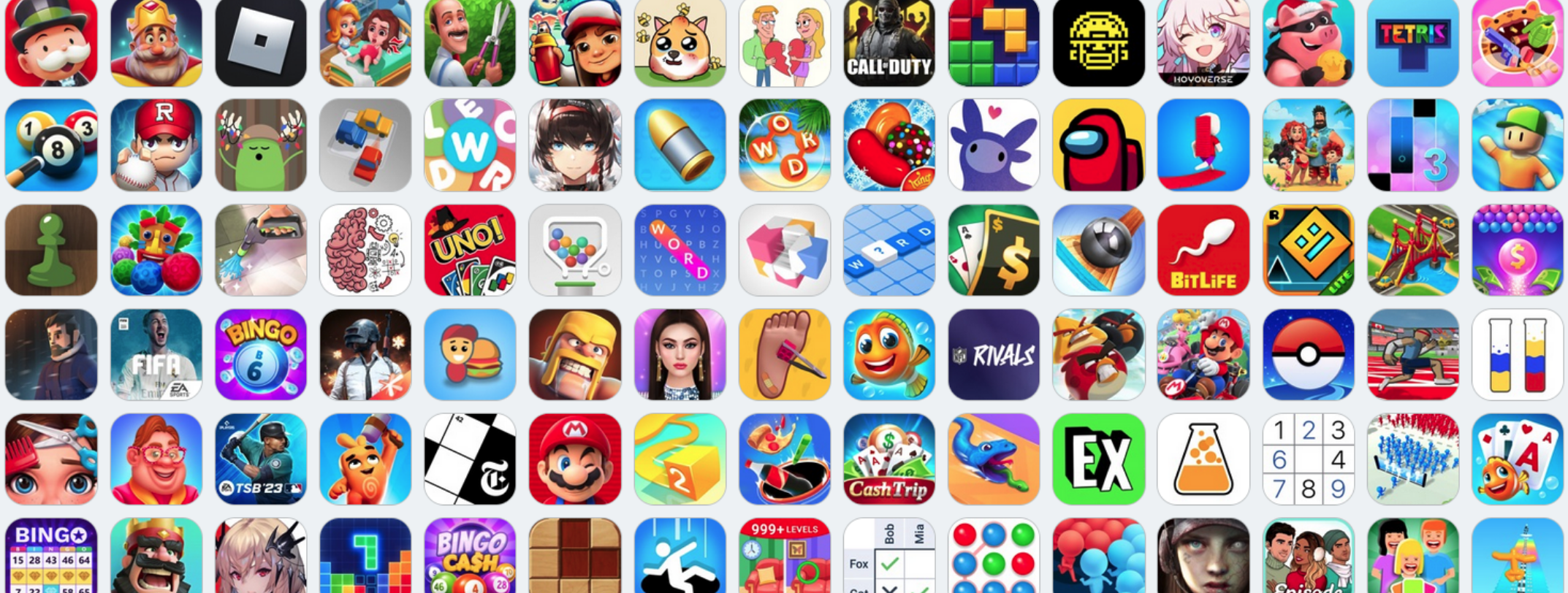When Apple introduced its App Tracking Transparency (ATT) policy in April 2021, it forced companies to seek permission from app users before tracking their data and activity across other apps and websites for advertising purposes.
This major privacy update has greatly impacted mobile marketers and advertisers by making it more difficult for them to access the data they rely on for user acquisition purposes. Snap, Facebook, Twitter and YouTube told the Financial Times that ATT was responsible for losses of nearly $10 billion at the time.
ATT permission is usually requested via an in-app pop-up notification where users can choose to allow or deny tracking on a per-app/game basis. While companies must get permission from users before tracking or collecting their data, there aren’t any guidelines regarding when or where this pop-up notification should appear in-app.
This got us wondering: is there an ideal time to ask users for data tracking consent? When do the top-grossing games display their ATT pop-up? And are there any additional tactics that the top-grossing games are using to encourage their players to agree to tracking?
We conducted a study to find out.
Analysis of ATT tracking pop-up data among US top-grossing 200 games
During this study, we manually inspected whether sample mobile games display ATT tracking consent pop-ups during a hypothetical “first session” (= the first 25 minutes of gameplay). We chose this time frame because it is a reasonable amount of time for a new user to spend on a game and can provide insight into whether or not the pop-up is displayed early on in the user’s experience.
However, it’s important to note that there may be games that are listed as not including any pop-ups, but do feature them beyond this sampling time frame. Therefore, while our study provides valuable insights into the prevalence of ATT tracking consent pop-ups during the first session, some games may still feature them later on in the user’s gameplay experience.
The study sample included the US top-grossing 200 list for iOS games, according to GameRefinery data that was accessed in late January, 2023. The list was analyzed and 99% of the games were inspected. The remaining 1% were not inspected because they were premium games (marked as “Na” in the charts below).
The data we gathered is valuable for game developers and publishers who aim to understand market trends and create successful games.
Furthermore, game developers can use this data to identify the features and characteristics that contribute the most to a game’s success, helping to guide the creation of new games or the improvement of existing ones. Through this analysis, we discovered when the most successful games in the US market were displaying ATT notifications.
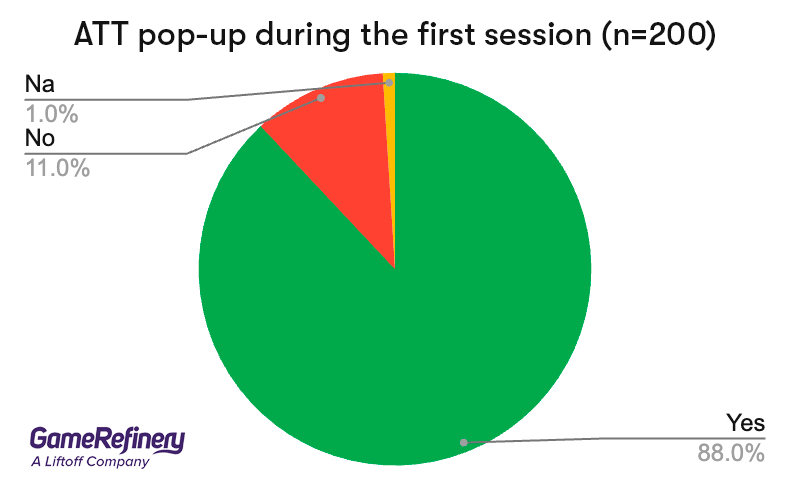
72% of top mobile games display ATT pop-ups within the first 30 seconds of gameplay
During the study, we found that the vast majority of sampled games (88%) included ATT pop-ups within the sampling time frame of 25 minutes. This indicates a general trend of app developers complying with Apple’s new privacy policy guidelines.
However, it is worth noting that a small but significant percentage of games, around 11%, featured no pop-ups within the same time frame. This may be because the pop-up features much later in the game or they are not even attempting to get access to the identifier.
Our analysis also found that 81.4% of the 177 games with ATT pop-ups displayed them within the first 30 seconds of gameplay. The timing of the pop-ups ranged from one second to 15 minutes and 44 seconds from starting the application, suggesting that some games are waiting to build trust with users during their gameplay session before requesting permission to track their data.
Nearly 70% of the top-grossing 50 iOS games request ATT permission during the first 15 seconds of gameplay
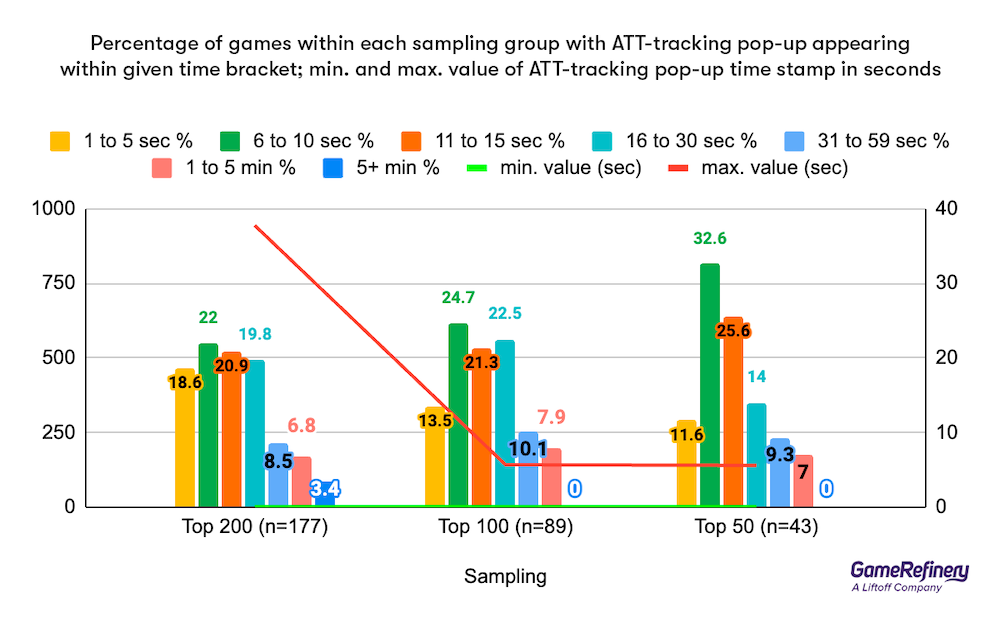
ATT pop-up timing amongst the top-grossing 100 games (n=89) ranged from one second to 2 minutes and 22 seconds with 82% of the games displaying the pop-up within the first 30 seconds of gameplay. Almost 70% of the top 100 games displayed the pop-up window between the first six to 30 seconds of gameplay.
While we’re unable to access data showing whether users accepted or denied these requests, our analysis suggests that game developers should prioritize displaying ATT pop-ups during the first 30 seconds of gameplay to increase their chances of users giving permission for data tracking.
Among the top 50 grossing games (n=43), ATT pop-up timing ranged from one second to two minutes and 20 seconds. 84% of these games displayed the pop-up within the first 30 seconds, and 58% of top-50 games displayed the pop-up between 6 and 15 seconds, further consolidating the finding that a “golden window” for ATT pop-up timing exists somewhere during the first six and 30 seconds of gameplay.
This suggests that developers should aim to display the pop-up early, but not too early, in order to maximize user engagement and compliance with ATT requirements.
Do personalized pre-ATT prompts improve the chances of user opt-in?
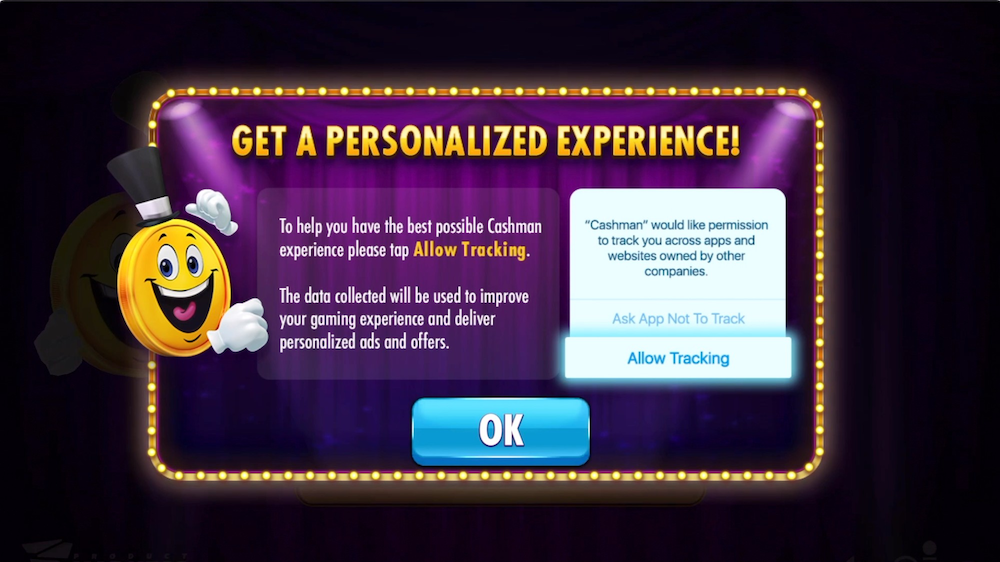
Some of the mobile games we analyzed displayed an additional pop-up before requesting ATT opt-in permission from their users, which we’ll call a pre-ATT prompt. These additional pop-ups are delivered to convince the user to allow ATT tracking, and 23% of the top-200 games we analyzed included a personalized pre-ATT prompt within the time frame of the sampling.
Top-grossing 100 games are more likely to display pre-ATT prompts
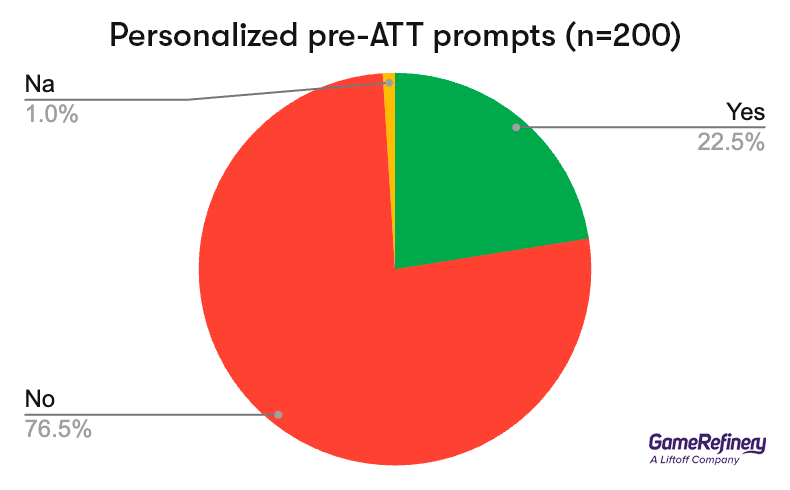
Our analysis found 26% (45/176) of sampled games with ATT pop-ups also included a personalized pre-ATT prompt. Interestingly, games that fall within the top-100 grossing chart were twice as likely to include a personalized pre-ATT prompt than games that rank 101-200. Out of the games ranked 1–100, 27 had personalized pre-ATT prompts, whereas only 18 games ranked 101-200 had personalized pre-ATT prompts.
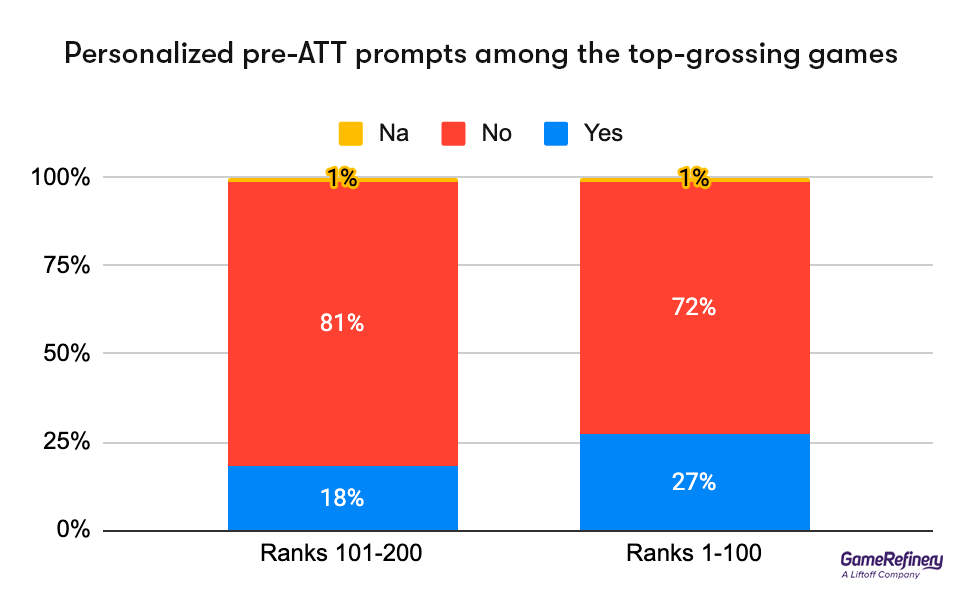
Based on this data, our analysis suggests that personalized pre-ATT prompts may be more common in top-grossing games or games that aim to maximize revenue through targeted advertising.
Games that generate more revenue are more likely to request additional user information
In addition to the above findings, our analysis also found a small percentage of games included additional prompts for user information. Specifically, 13% of the sampled games included some kind of additional prompts, such as requests for email addresses, phone numbers, age, gender, and other personal data.
Like the findings above, the percentage of games displaying additional prompts varied depending on their ranking in the top-grossing chart. 17% of mobile games in the top-grossing 100 chart included an additional data prompt, compared to only 9% of games ranked between 101–200. This indicates that games that generate higher revenue are 89% more likely to request additional user information than games ranked between 101 and 200.
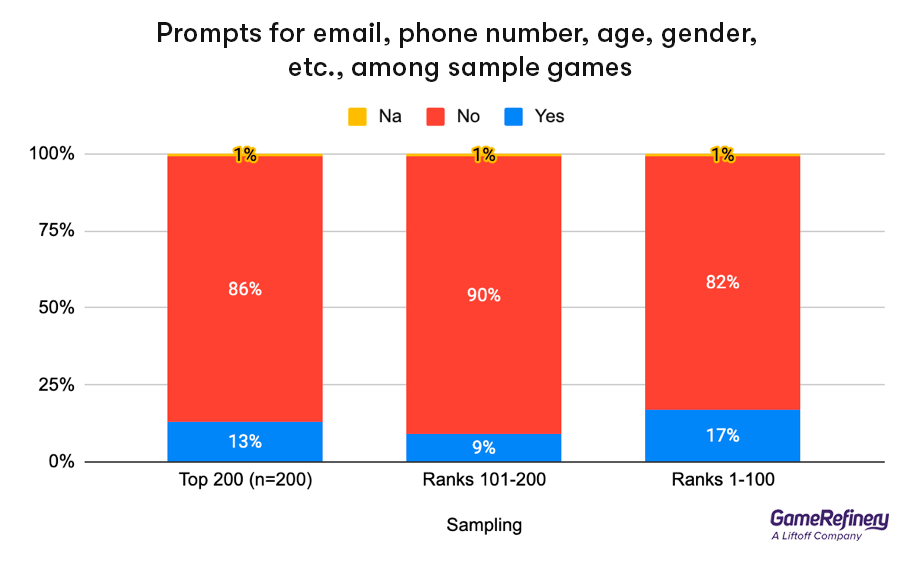
It is worth noting that this trend raises questions about the privacy and security of user data. While some users may not mind providing this information, others may feel uncomfortable sharing personal details. Game developers should be transparent about their data collection practices and ensure user data is properly protected.
Additionally, it may be beneficial for game developers to consider alternative ways to monetize their games, rather than relying solely on user data collection. This could help build trust with users and create a more positive user experience.
Displaying ATT notifications early could improve the chances of opt-in for users
After analyzing the ATT frequency and the time notifications appear amongst the top-200 grossing iOS games, our data suggests that the first 30 seconds of gameplay is the sweet spot for displaying ATT pop-ups.
It’s important to note that we weren’t able to access data showing whether customers were accepting or refusing these notifications, but the trend of higher-grossing mobile games displaying ATT notifications earlier during gameplay suggests that early requests are more successful. This deduction is based on the assumption that developers of higher-grossing mobile games are adjusting their ATT notification display time point based on their individual experience of how users are responding to their notification.
We’ve summarized the key findings from this data below:
- 81.4% of the games displaying some kind of ATT-related pop-up did so within the first 30 seconds of gameplay.
- Among the top-grossing 50 games (n=43), 58% displayed the pop-up between the first six and 15 seconds of gameplay. However, we believe that displaying the pop-up during the first five seconds of gameplay may be unpopular among top games due to a higher likelihood of users instinctively rejecting the pop-up.
- Our research also found that only 25.6% (45/176) of sampled games with ATT pop-ups included a personalized pre-ATT prompt.
- Games in the top 100 grossing were 50% more likely to include a personalized pre-ATT prompt than games in top-grossing ranks 101-200.
- 13% of sampled games also included some kind of additional prompts for user information, including email, phone number, age, gender, etc.
- Top-100 grossing games were 89% more likely to include additional prompts than games among ranks 101-200.
If you enjoyed reading this post, here are a few more you should definitely check out:

